Research on the Flexural Behavior of Profiled Steel Sheet–Hollow Concrete Composite Floor Slab
Abstract
1. Introduction
2. Test Plan
2.1. Test Specimens and Equipment
2.2. Test Loading Plan and Measurement Content
3. Analysis of Test Phenomena and Results
3.1. Test Phenomena
3.2. Analysis of Test Results
3.2.1. Key Loads
3.2.2. Mid-Span Deflection
3.2.3. Ductility Coefficient
3.2.4. Crack Analysis
3.2.5. Key Position Strain Analysis
4. Finite Element Comparison
4.1. Element Selection and Mesh Generation
4.2. Contact Configurations
4.3. Loading Method and Boundary Conditions
4.4. The Constitutive Relationship Between Concrete and Steel
4.5. Finite Element Model Verification
4.5.1. Model Accuracy Verification
- Comparison of load–deflection curves
- 2.
- Stress and strain analysis of the composite floor slabs
4.5.2. Analysis of the Factors Influencing the Parameters of the Profiled Steel Sheet-Hollow Concrete Composite Floor Slabs
- The influence of the hollow rate
- 2.
- The influence of the thickness of the profiled steel sheet
- 3.
- The influence of the composite slab thickness
5. Calculation of Normal Section Flexural Bearing Capacity of the Composite Reinforced Concrete
5.1. Calculation of Normal Section Flexural Bearing Capacity in Full Anchorage Stage
5.2. Calculation of Normal Section Flexural Bearing Capacity Considering the Anchorage Degree
6. Conclusions
- (1)
- The failure mode of the hollow concrete composite floor slabs is closely related to the interface bonding state and reinforcement arrangement conditions; when the profiled steel sheet is in a relatively low anchorage working condition, the specimens without reinforcement arrangement fail due to interface debonding and slip effects during the loading process, and the specimens exhibit a brittle failure characteristics. When the profiled steel sheet forms an effective combination with the concrete, its lower flange fully exerts its tensile performance, and the failure mode of the specimen changes to a ductile failure.
- (2)
- Increasing the hollow rate within a certain range (not larger than 16.5%) has little effect on the flexural bearing capacity. As the reinforcement ratio increases from 0% to 0.6%, the ultimate bearing capacity is increased by 182.5%, and the ductility coefficient is increased by 246.0%. The ultimate deflection of specimens with a reinforcement ratio of 0.6% was 22.4 times that of specimens without reinforcement arrangement. When the thickness of the steel sheet increases from 0.9 mm to 1.1 mm, its ultimate load and ultimate deflection increases by 23.9% and 4.0%, respectively. The reinforcement ratio has a significant impact on the ultimate bearing capacity, deflection, and ductility coefficient of the composite floor slabs.
- (3)
- The upper flange of the profiled steel sheet of all specimens undergoes a transition of the tensile and compressive state, but does not reach yielding, which indicates that this part mainly undertakes the pressure transmission role in the structural system. The specimens with a reinforcement arrangement show significant ductility advantages, and the double-position yielding phenomenon of the lower flange indicates that the reinforcement arrangement can compensate for the stiffness degradation caused by interface slip.
- (4)
- The anchorage degree of the composite floor slabs has a significant impact on the ultimate flexural bearing capacity. The existing method for the normal section flexural bearing capacity is based on the condition that the composite floor slabs are in a fully anchorage state. In order to better analyze the normal section flexural bearing capacity of the composite slabs under different anchorage states, a calculation method for the flexural bearing capacity under different anchorage degrees is proposed. The theoretical results are in good agreement with the experimental values, which have a certain reference value for the engineering practice.
Author Contributions
Funding
Data Availability Statement
Conflicts of Interest
References
- Islam, S.M.Z.; Ahmed, B.; Sayed, A.; Siddique, M.J. Structural strength and behavior of profiled steel sheet-concrete composite slab. In Proceedings of the 5th International Conference on Civil Engineering for Sustainable Development (ICCESD 2020), Khulna, Bangladesh, 7–9 February 2020. [Google Scholar]
- Zhao, H.; Zhao, J.; Wang, R.; Zhang, W.; Liu, F.; Wu, S. Thermal behavior of composite slabs with closed profiled steel decking and recycled aggregate concrete in fire. Fire Saf. J. 2022, 132, 103637. [Google Scholar] [CrossRef]
- Siddh, S.P.; Patil, Y.D.; Patil, H.S. Experimental studies on behaviour of composite slab with profiled steel sheeting. Mater. Today 2017, 4, 9792–9796. [Google Scholar] [CrossRef]
- Guo, F.; Li, G.; Yang, Z.; Zhang, X. Research on Bond-Slippage Property of Long-Span Opened Profiled Steel Sheeting—Concrete Composite Slabs. Ind. Constr. 2017, 47, 190–195. (In Chinese) [Google Scholar]
- Baskar, R.; Antony, J.C. Experimental and Numerical Studies on Composite Deck Slabs. Int. J. Eng. Res. Dev. 2012, 12, 22–32. [Google Scholar]
- Al-Azzawi, A.A.; Al-Aziz, B.M.A. Behavior of reinforced lightweight aggregate concrete hollow-core slabs. Comput. Concr. 2018, 21, 117–126. [Google Scholar]
- Li, X.; Zheng, X.; Ashraf, M.; Li, H. Experimental study on the longitudinal shear bond behavior of lightweight aggregate concrete-closed profiled steel sheeting composite slabs. Constr. Build. Mater. 2017, 156, 599–610. [Google Scholar] [CrossRef]
- Aarthi, D.; Jeyshankaran, E.; Aranganathan, N. Comparative study on longitudinal shear resistance of light weight concrete composite slabs with profiled sheets. Eng. Struct. 2019, 200, 109738. [Google Scholar] [CrossRef]
- Lv, J.; Zhou, T.; Wu, H.; Sang, L.; He, Z.; Li, G.; Li, K. A New Composite Slab Using Crushed Waste Tires as Fine Aggregate in Self-Compacting Lightweight Aggregate Concrete. Materials 2020, 13, 2551. [Google Scholar] [CrossRef]
- Ekberg, C.E., Jr.; Schuster, R.M.; Porter, M.L. Further Investigation of Light Gage Steel Forms As Reinforcement for Concrete Slabs. In AISI-Specifications for the Design of Cold-Formed Steel Structural Members; Missouri University of Science and Technology: Rolla, MO, USA, 1969; Available online: https://scholarsmine.mst.edu/ccfss-aisi-spec/89 (accessed on 12 May 2025).
- Wright, H.D.; Evans, H.R.; Harding, P.W. The use of profiled steel sheeting in floor construction. J. Constr. Steel Res. 1987, 7, 279–295. [Google Scholar] [CrossRef]
- Chen, S. Load carrying capacity of composite slabs with various end constraints. J. Constr. Steel Res. 2003, 59, 385–403. [Google Scholar] [CrossRef]
- Cifuentes, H.; Medina, F. Experimental study on shear bond behavior of composite slabs according to Eurocode 4. J. Constr. Steel Res. 2013, 82, 99–110. [Google Scholar] [CrossRef]
- Ahmed, S.M.; Avudaiappan, S.; Sheet, I.S.; Flores, E.I.S.; Pina, J.C.; Yanez, S.J.; Guzmán, C.F. Prediction of longitudinal shear resistance of steel-concrete composite slabs. Eng. Struct. 2019, 193, 295–300. [Google Scholar] [CrossRef]
- Soltanalipour, M.; Ferrer, M.; Marimon, F.; Holomek, J.; Bajer, M.; Melcher, J.; Karmazínová, M. Shear transfer behavior incomposite slabs under 4-point standard and uniform-load tests. J. Constr. Steel Res. 2020, 164, 105774. [Google Scholar] [CrossRef]
- Soltanalipour, M.; Ferrer, M.; Marimon, F. An experimentally validated study for open rib profiles steel-concrete composite slabs behavior in partial connection. In Proceedings of the 14th Nordic Steel Construction Conference, Copenhagen, Denmark, 18–20 September 2019; Volume 3, pp. 271–276. [Google Scholar]
- Grossi, L.; Santos, C.; Malite, M. Longitudinal shear strength prediction for steel-concrete composite slabs with additional reinforcement bars. J. Constr. Steel Res. 2020, 166, 105908. [Google Scholar] [CrossRef]
- Heweidak, M.; Kafle, B.; Al-Ameri, R. Shear-Bond Behaviour of Profiled Composite Slab Incorporated with Self-Compacted Geopolymer Concrete. Appl. Sci. 2022, 12, 8512. [Google Scholar] [CrossRef]
- Lim, S.S.; Wong, J.Y.; Yip, C.C.; Pang, J.-W. Flexural strength test on new profiled composite slab system. Case Stud. Constr. Mat. 2021, 15, e00638. [Google Scholar] [CrossRef]
- Shi, G. Study on the Method for Calculating the Flexural Rigidity of Reinforced Concrete Truss Hollow Composite Slabs. Buildings 2025, 15, 586. [Google Scholar] [CrossRef]
- Yang, L.; Shen, Q.; Lu, M.; Yang, X. Experimental Study on Bending Behaviors of Ultra-High-Performance Fiber-Reinforced Concrete Hollow-Core Slabs. Buildings 2025, 15, 812. [Google Scholar] [CrossRef]
- Gu, G. Study On Shear Experiment and Grouting Reinforcement Method of Prestressed Hollow Slab Beam. Master’s Thesis, Southeast University, Shenyang, China, 2021. (In Chinese). [Google Scholar]
- Chung, L.; Lee, S.-H.; Cho, S.-H.; Woo, S.-S.; Choi, K.-K. Investigations on flexural strength and stiffness of hollow slabs. Adv. Struct. Eng. 2010, 13, 591–601. [Google Scholar] [CrossRef]
- Prakashan, L.; George, J.; Edayadiyil, J.B.; George, J.M. Experimental study on the flexural behavior of hollow core concrete slabs. Appl. Mech. Mater. 2017, 857, 107–112. [Google Scholar] [CrossRef]
- Alzein, R.; Kumar, M.V. Development of Concrete Slabs by Using Hollow Core Action Integrated with Profiled Steel Sheets: State of the Art Review. Int. J. Steel Struct. 2023, 23, 645–663. [Google Scholar] [CrossRef]
- Zhao, W. Study on Mechanical Behavior of the Cast-in-Situ Pre-Stressed Concrete Two-Way Hollow Slab with Tube Fillers. Master’s thesis, Xiangtan University, Xiangtan, China, 2015. (In Chinese). [Google Scholar]
- Mahdi, A.A.; Ismael, M.A. Structural Behavior of Hollowcore One Way Slabs of High Strength Self-compacting Concrete. Int. J. Eng. 2021, 34, 39–45. [Google Scholar]
- Liu, Y. Study on Mechanical Properities of Fabricated Prestressed Iron Tailings Concrete Hollow Slabs. Master’s thesis, Hebei Institute of Architecture and Technology, Zhangjiakou, China, 2018. (In Chinese). [Google Scholar]
- Zhang, H. Development and Mechanical Performance Research of New Hollow Composite Slabs. Master’s Thesis, Shenyang Jianzhu University, Shenyang, China, 2020. (In Chinese). [Google Scholar]
- GB/T 50152-2012; Standard for Test Method of Concrete Structures. China Architecture Publishing & Media Co., Ltd.: Beijing, China, 2012.
- GB 50010-2010; National Standards of the People’s Republic of China-Code for Design of Concrete Structures. China Architecture Publishing & Media Co., Ltd.: Beijing, China, 2010.
- JGJ 138-2016; Code for Design of Composite Structures. China Architecture Publishing & Media Co., Ltd.: Beijing, China, 2016.
- Nie, J.G.; Tang, L.; Huang, L. Load-carrying and Deforming Capacities of Composite Slabs with Re-entrant Trough Profiled Steel Sheeting(I): Experiment and Longitudinal Shear Capacity. Build. Struct. 2007, 1, 60–64. [Google Scholar]
- GB 50017-2017; Standard for Design of Steel Structures. China Architecture Publishing & Media Co., Ltd.: Beijing, China, 2017.

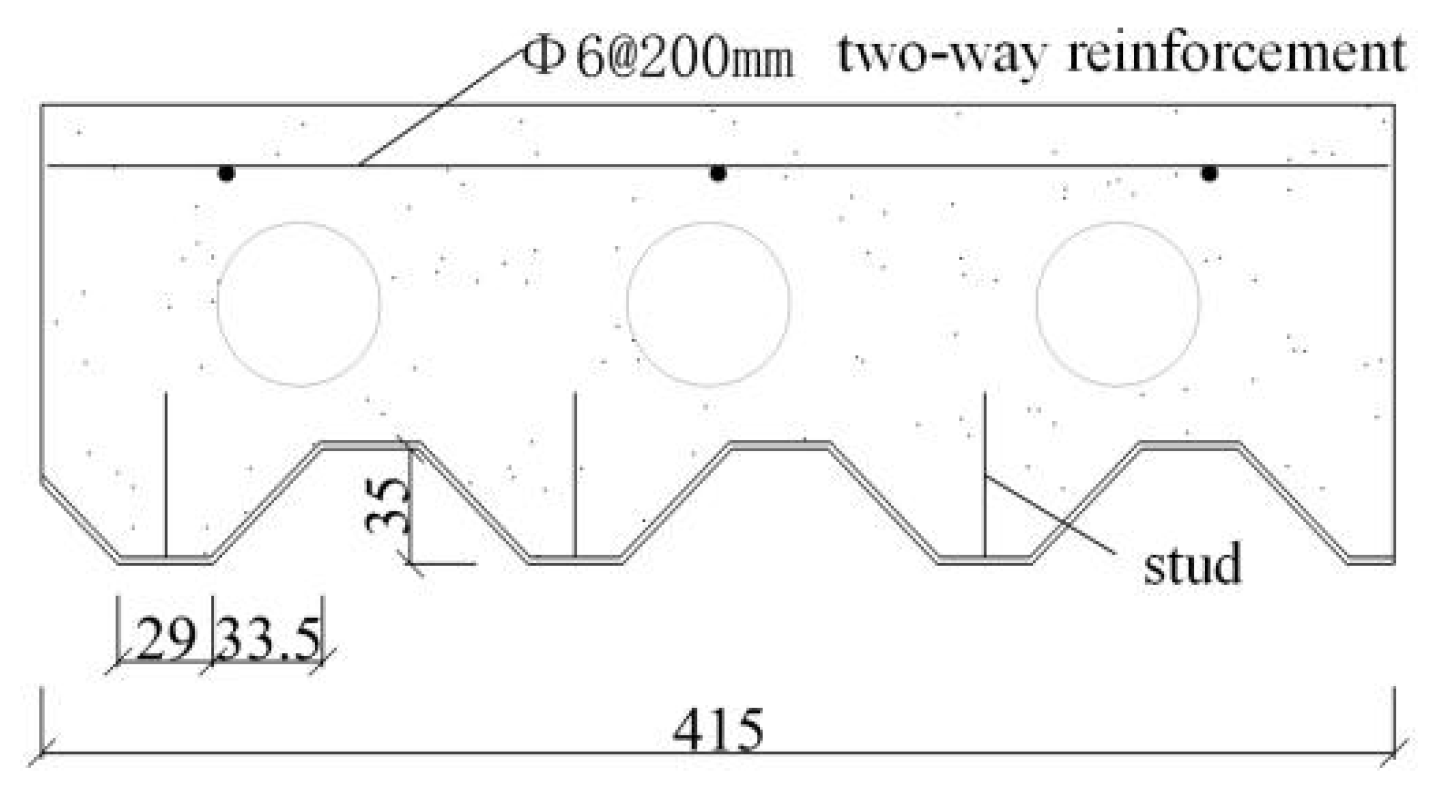

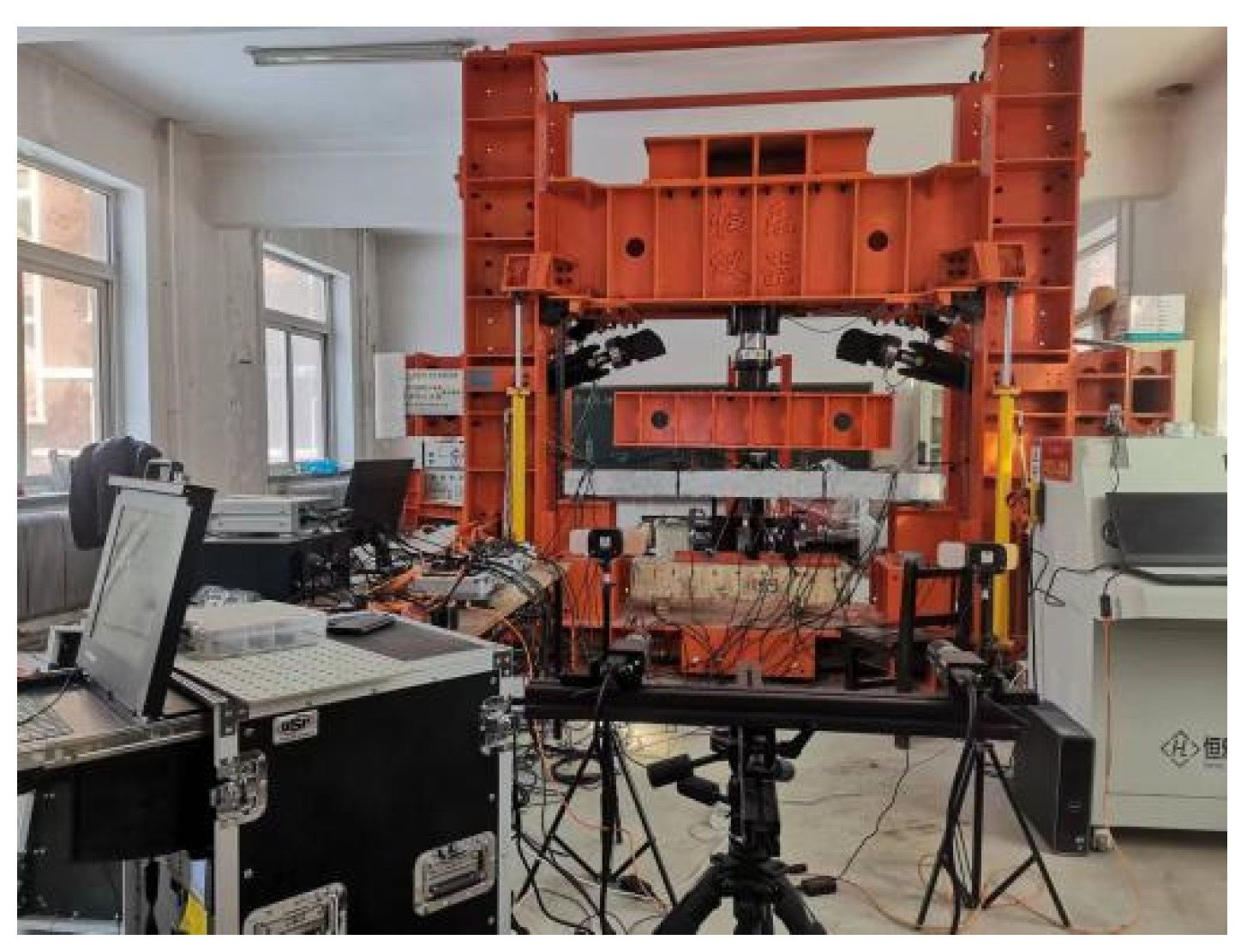



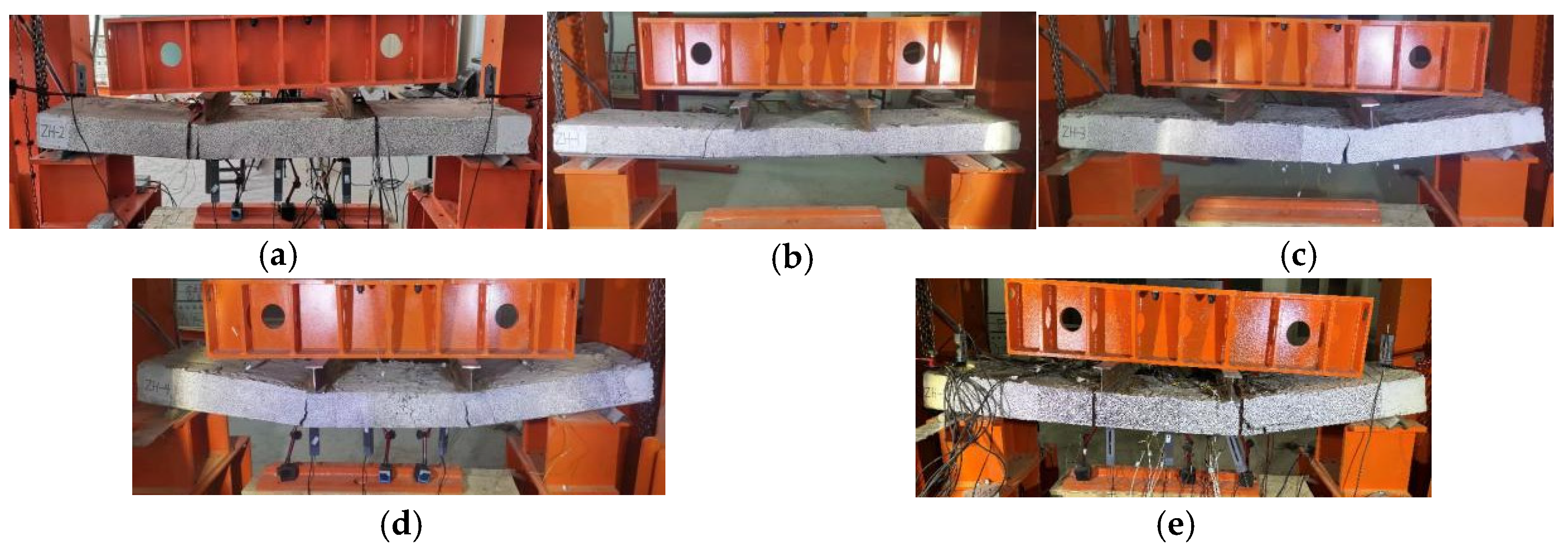
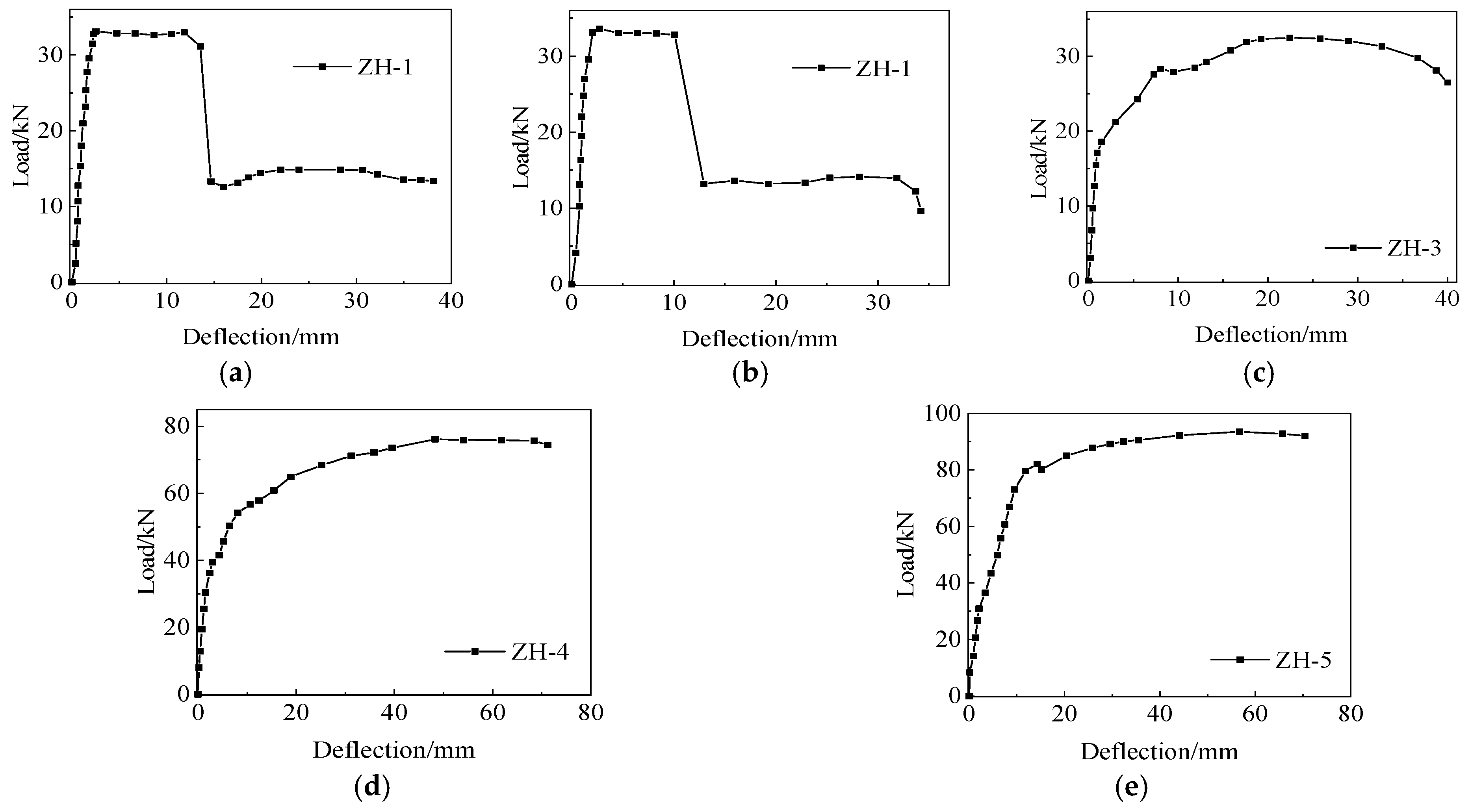
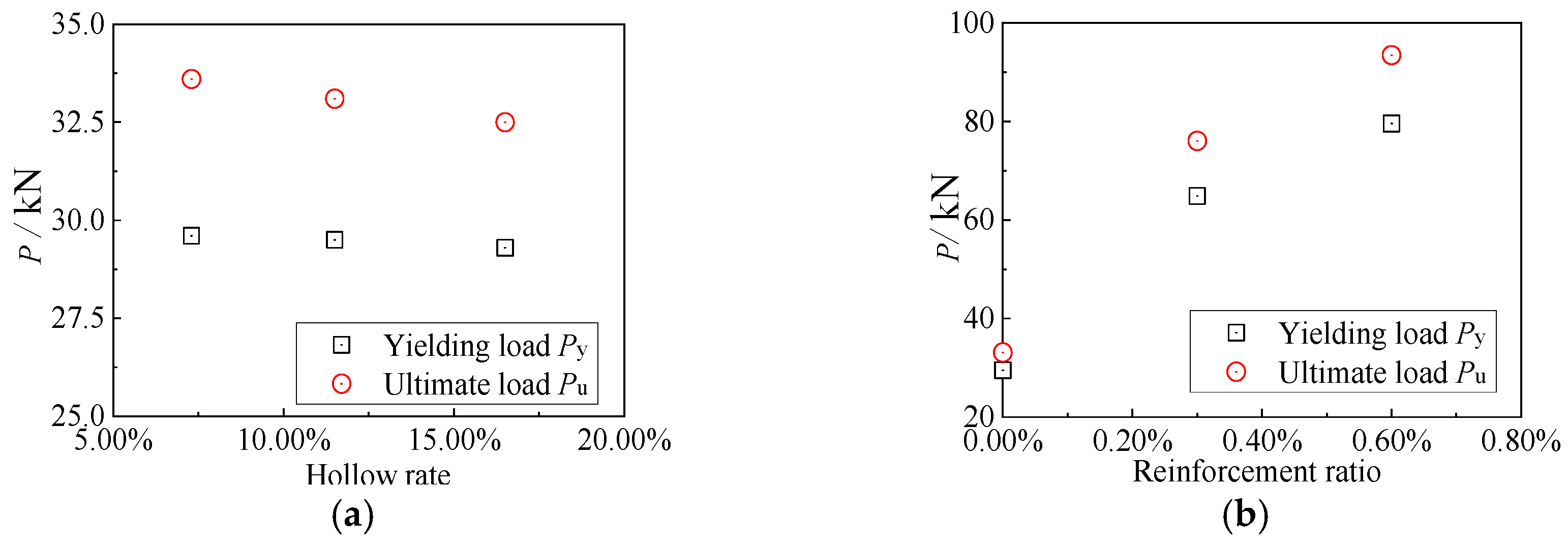
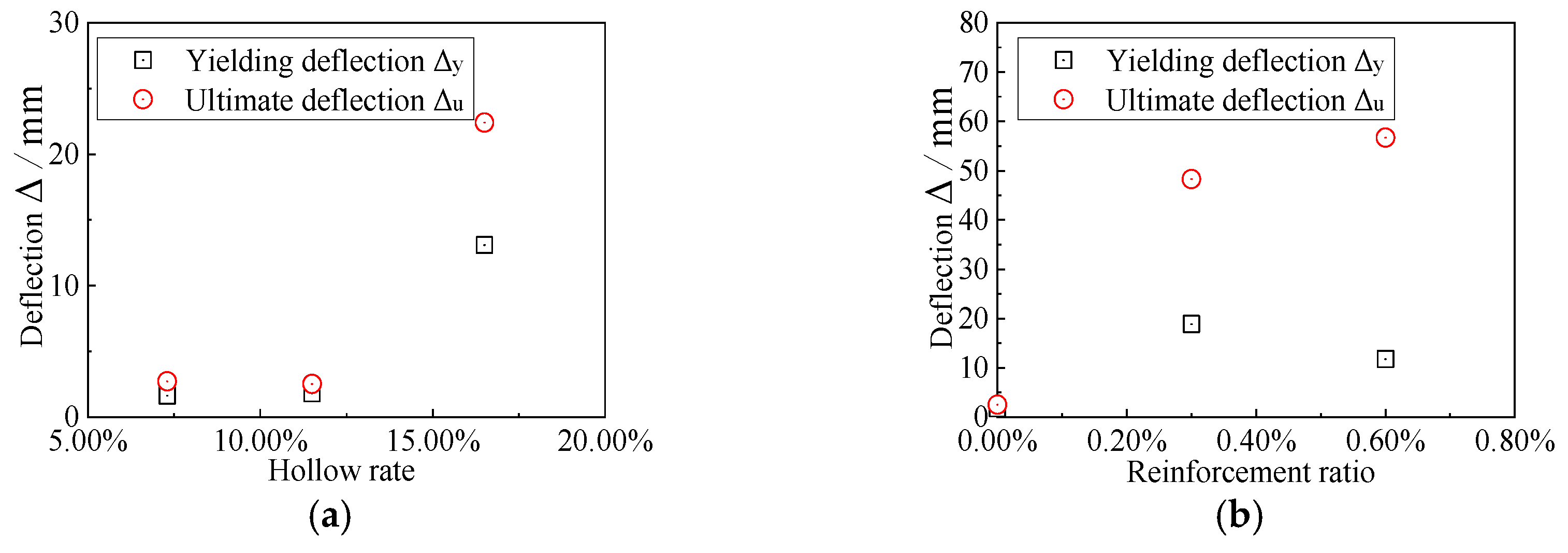


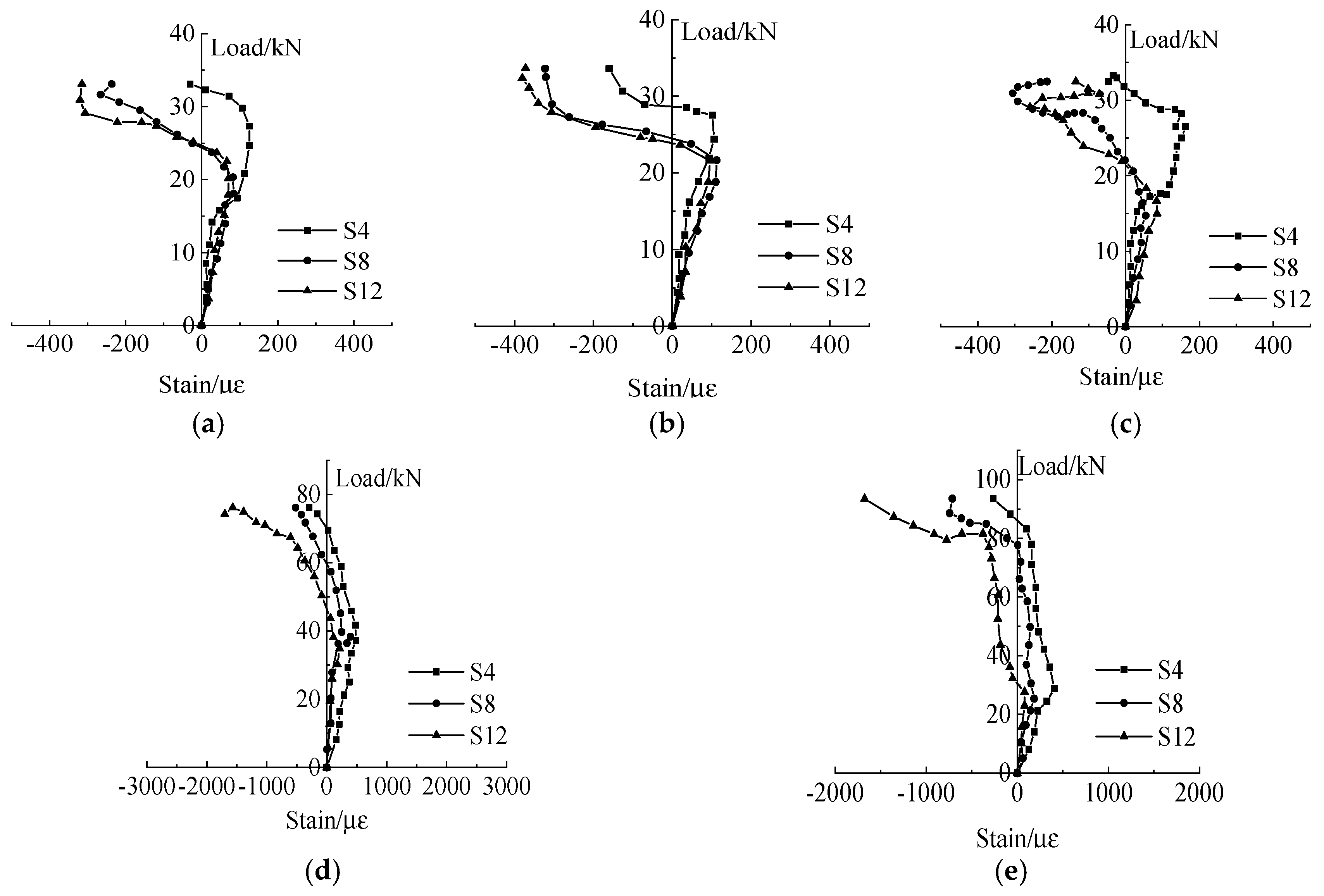
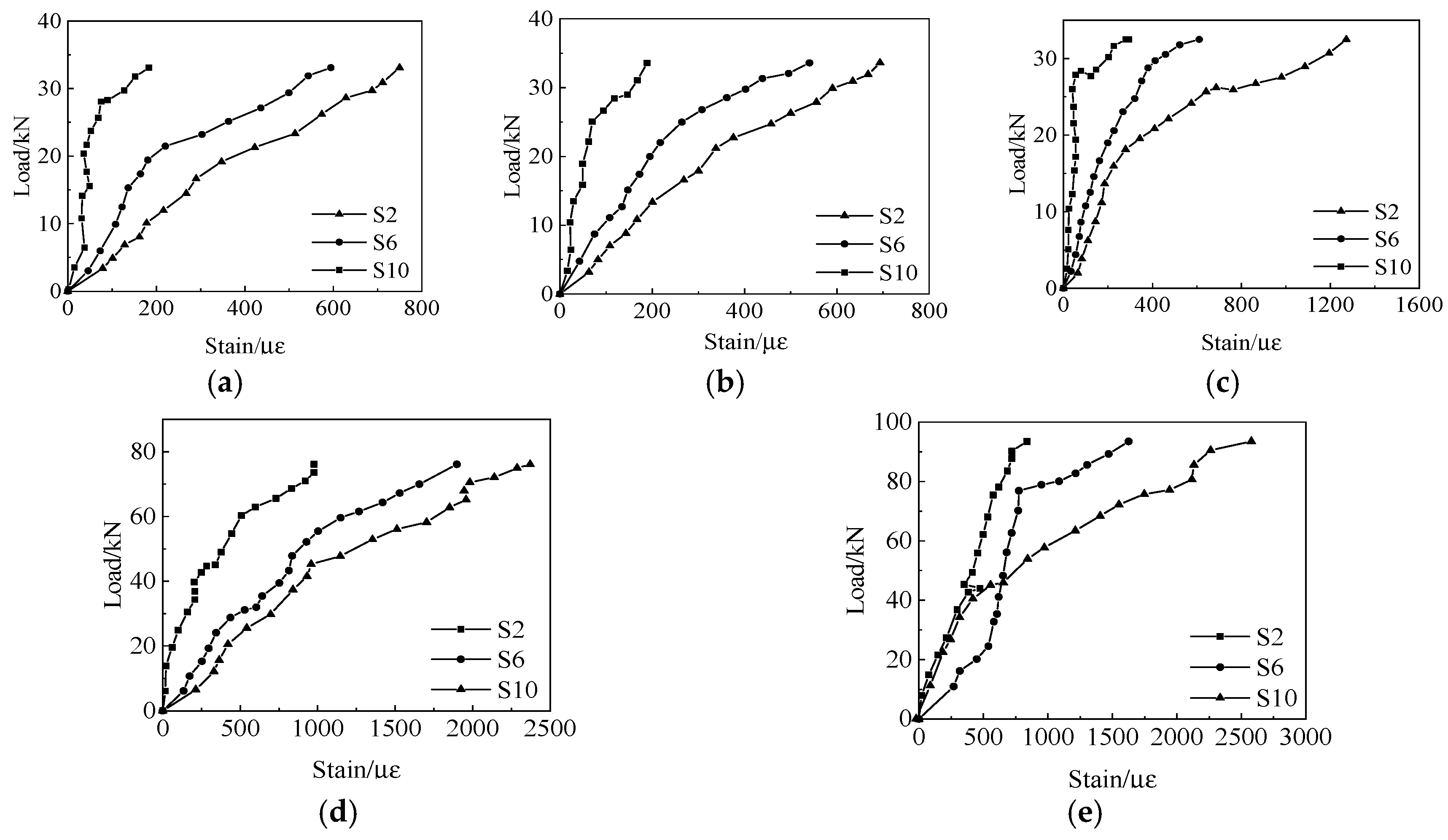

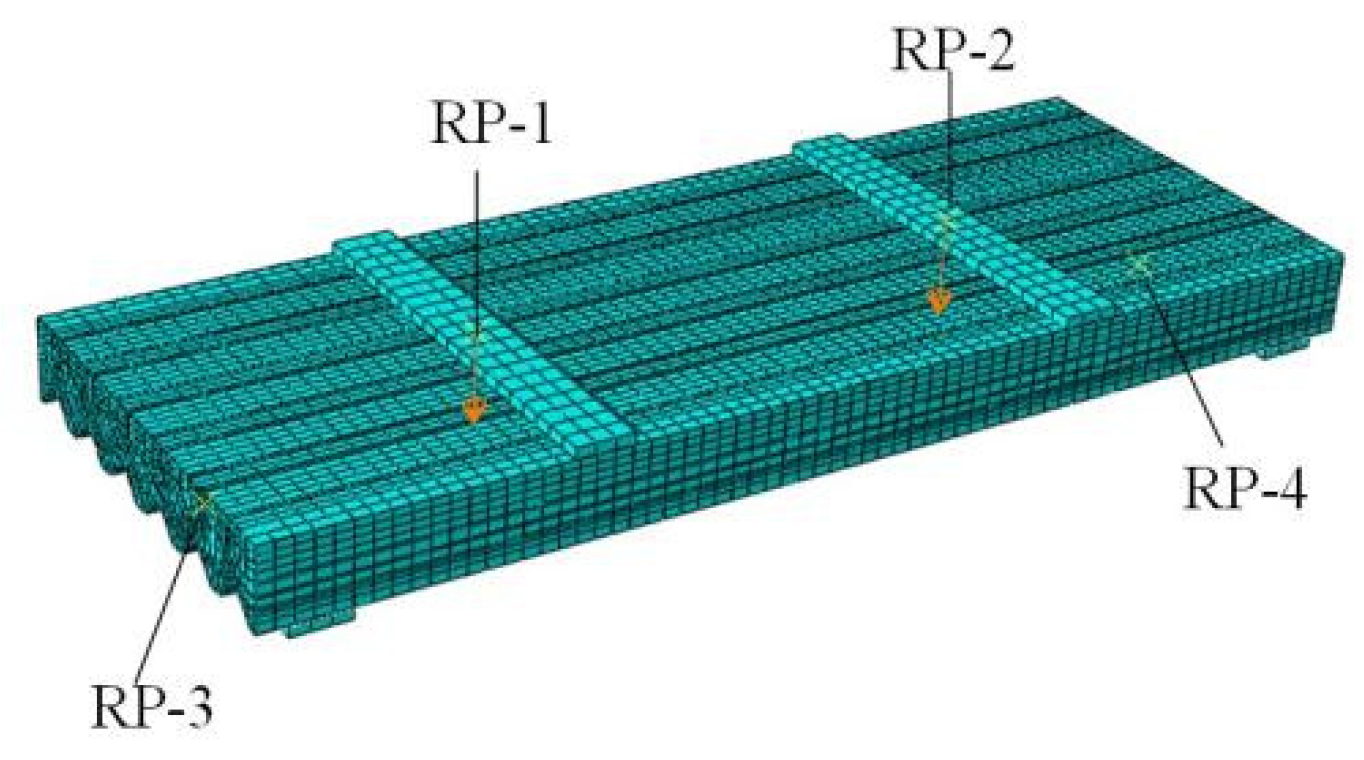
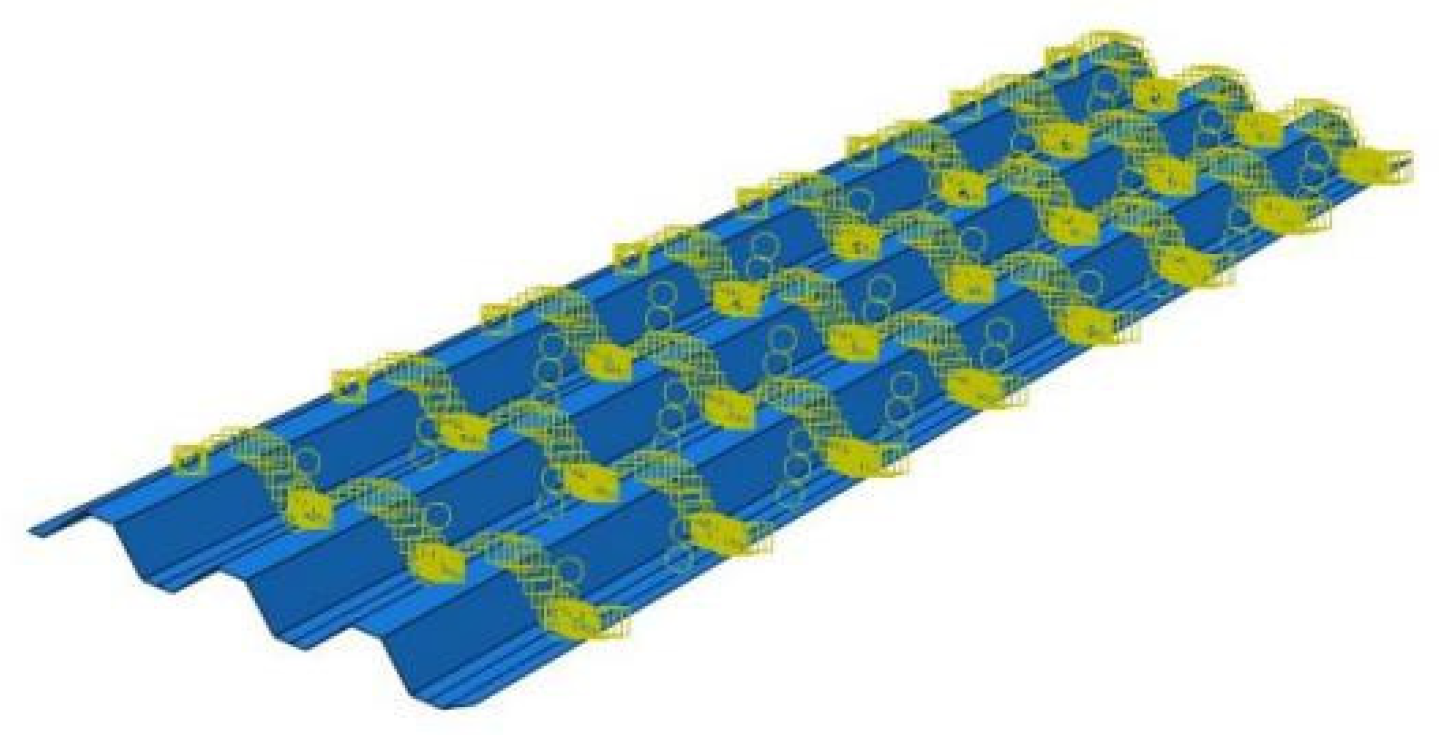
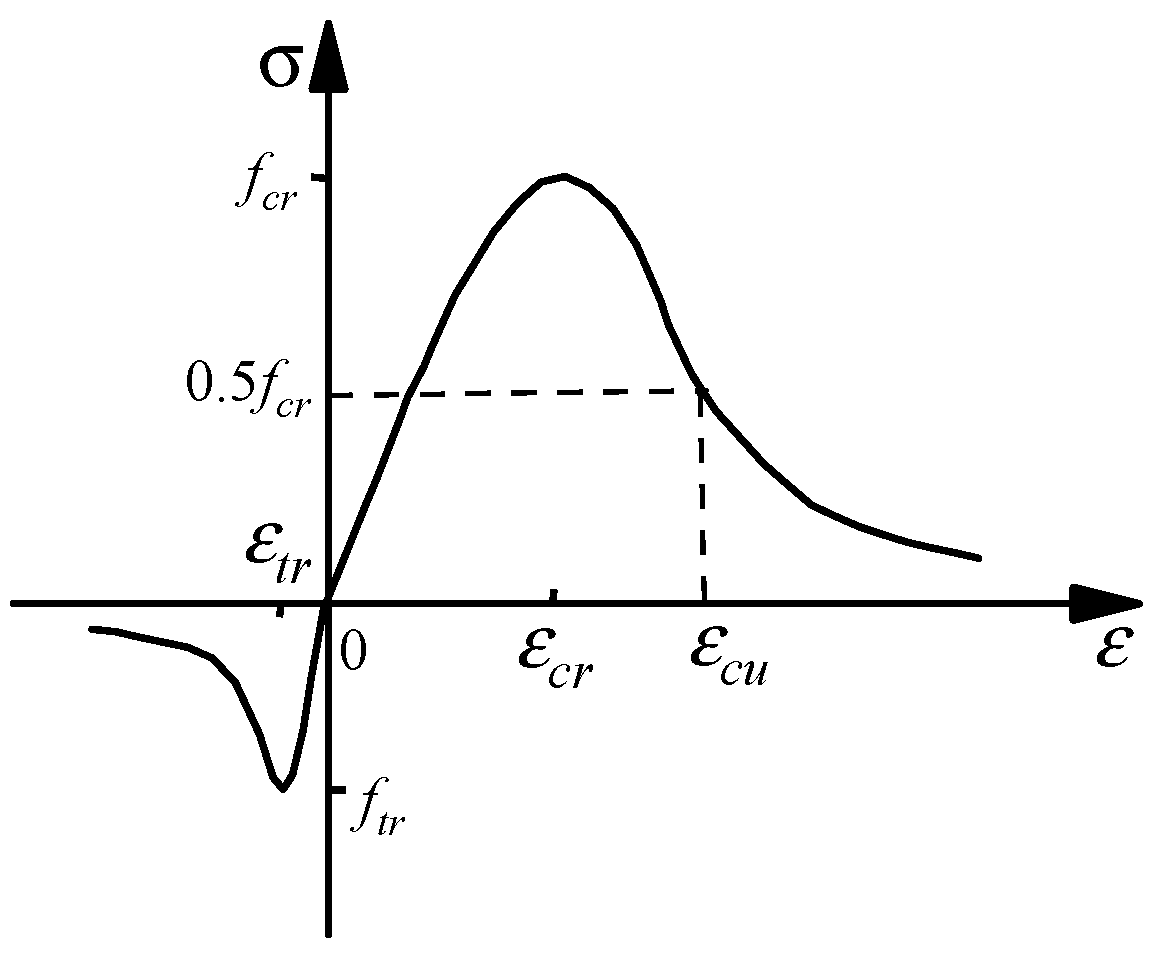
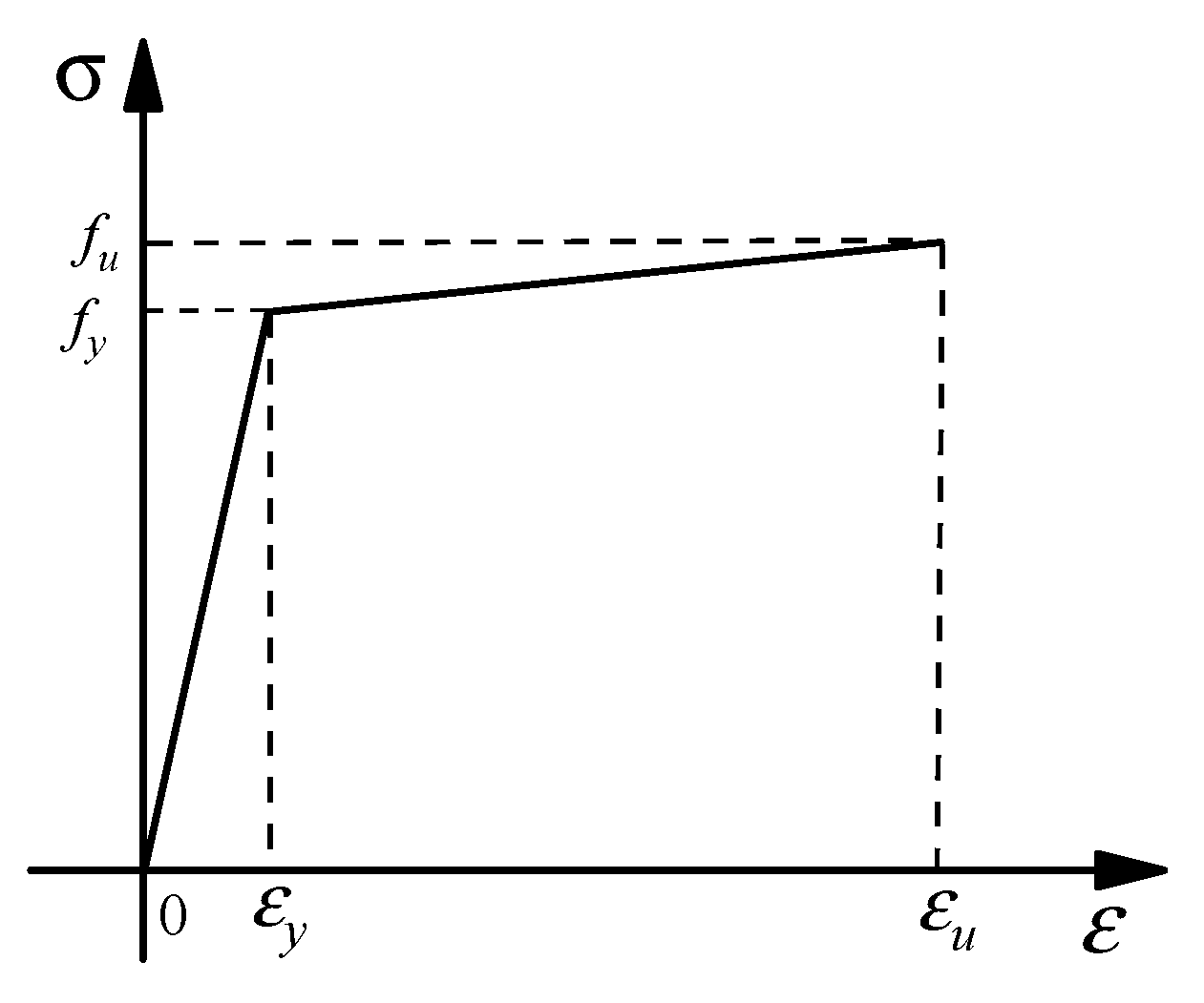
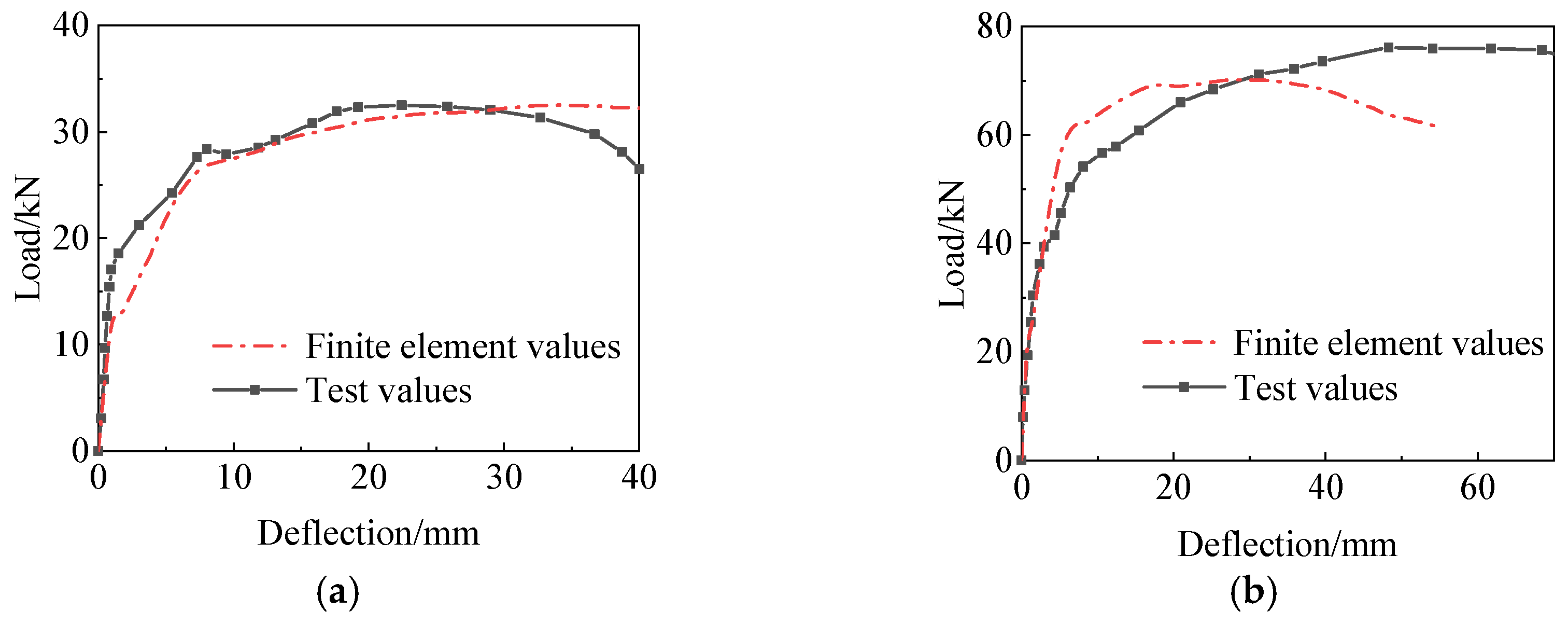

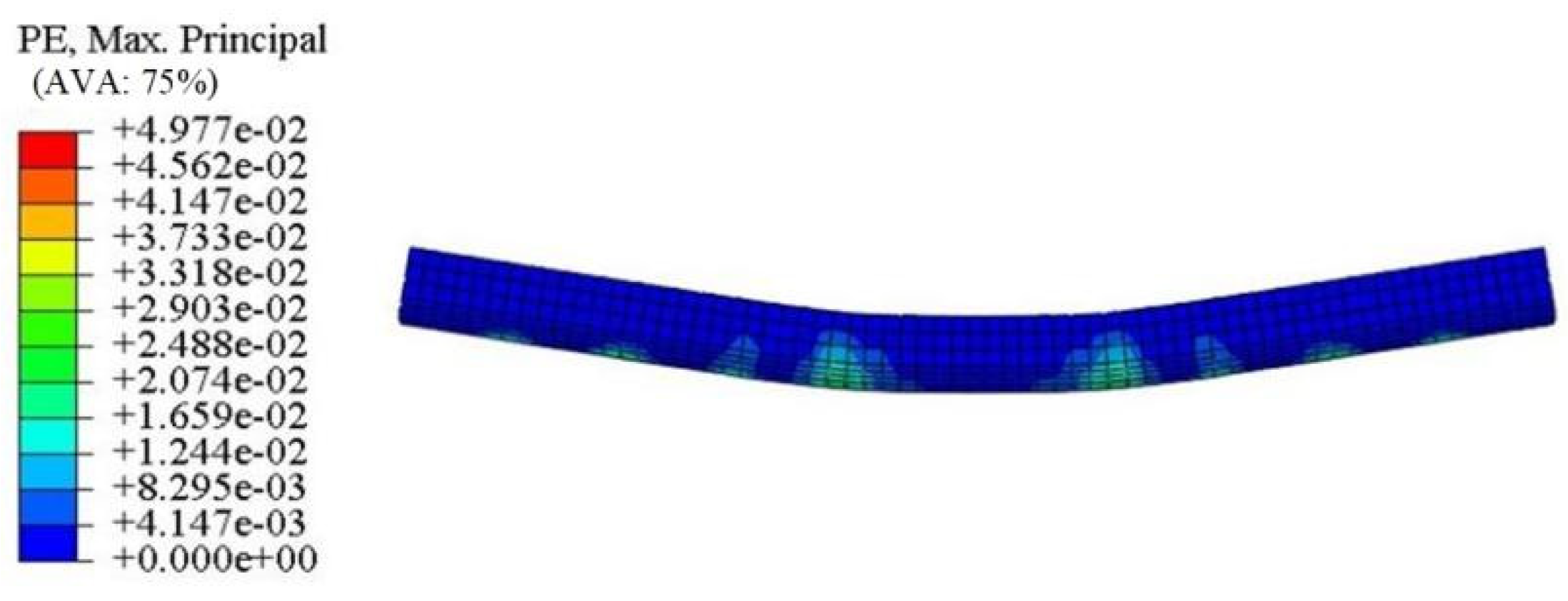
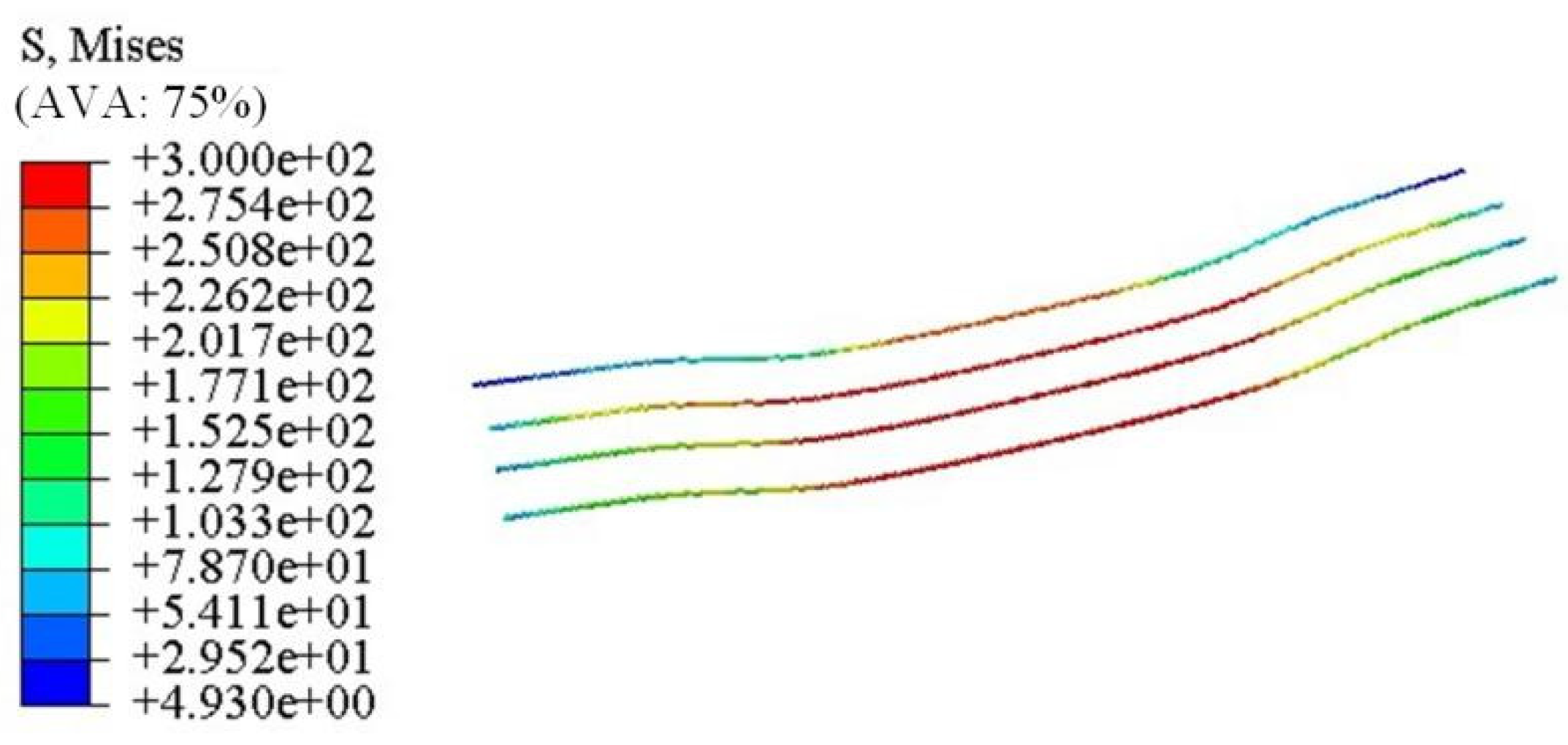
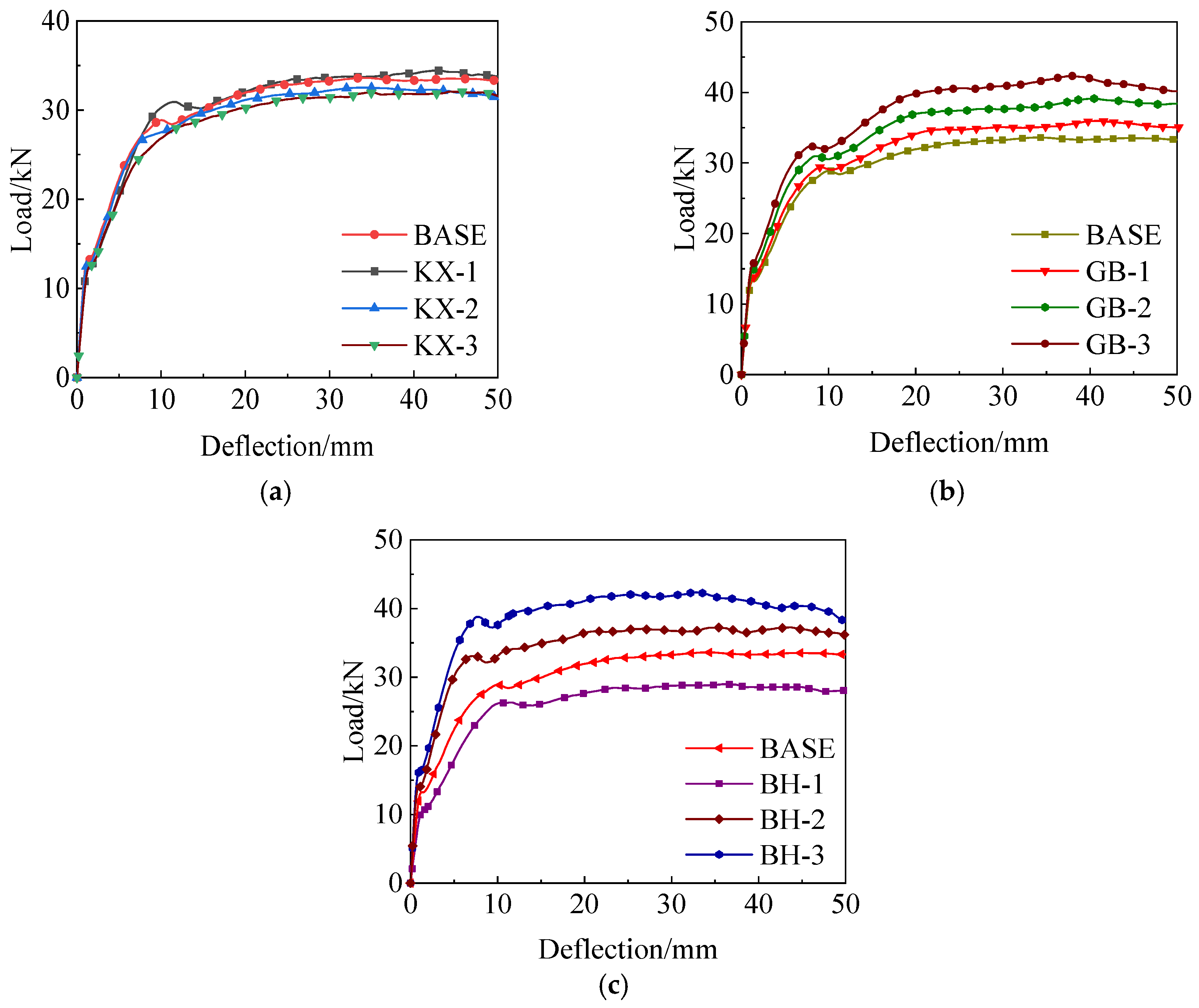

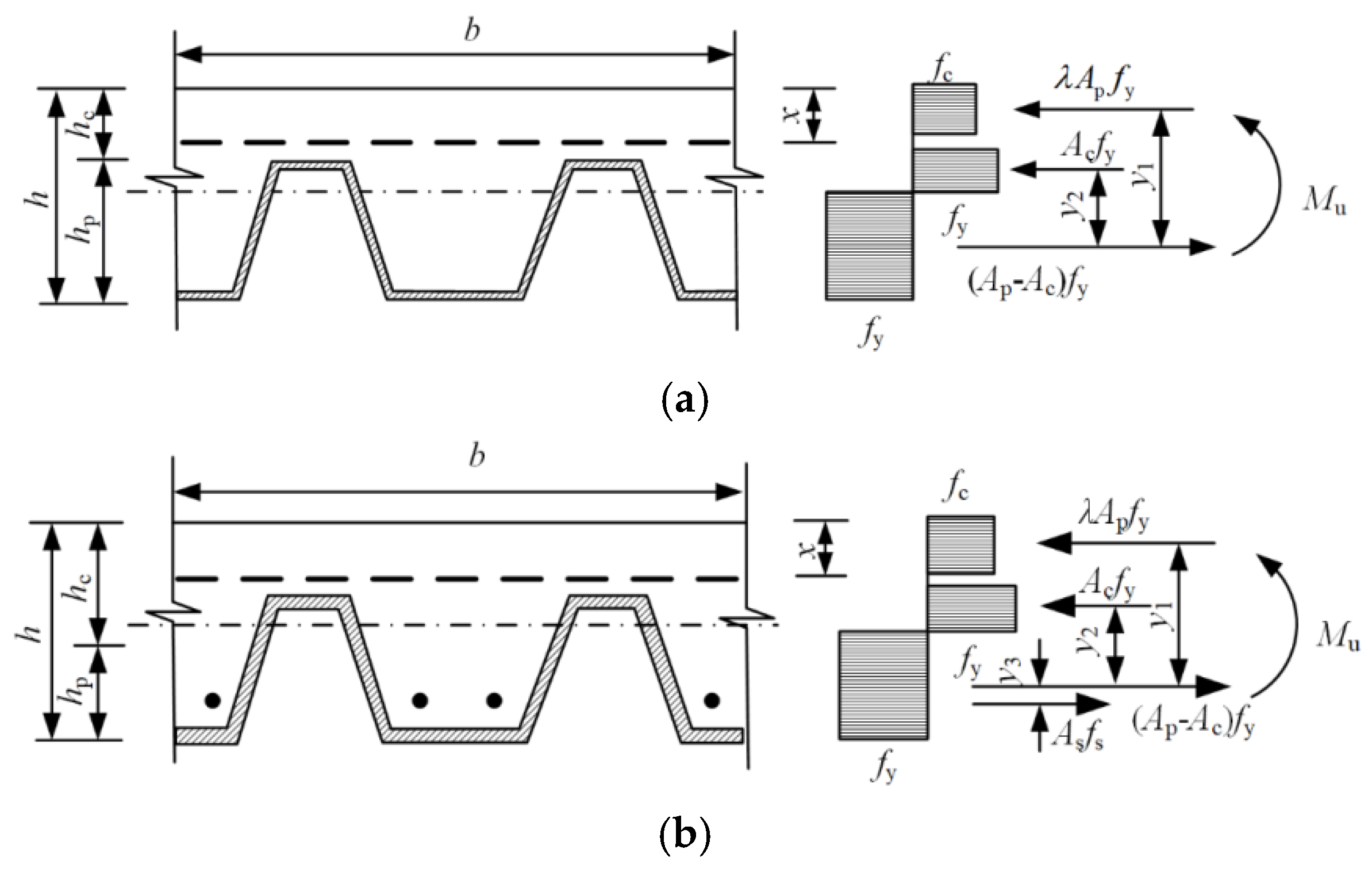
| Width/mm | Thickness /mm | Yielding Strength /MPa | Tensile Strength /MPa | Elastic Modulus E /MPa | Section Inertia Moment /(cm4/m) | Weight Per Square Meter/kg |
|---|---|---|---|---|---|---|
| 830 | 0.8 | 227.83 | 319.04 | 2.06 × 105 | 181.3 | 10.46 |
| Reinforcement Specification | /MPa | /MPa | /MPa | Elongation After Fracture/% |
|---|---|---|---|---|
| A10 | 300 | 420 | 2.06 × 105 | 25 |
| No. | Reinforcement Arrangement | Reinforcement Ratio/% | Hollow Radius/mm | Hollow Rate/% |
|---|---|---|---|---|
| ZH-1 | 0 | 0 | 25 | 11.5 |
| ZH-2 | 0 | 0 | 20 | 7.3 |
| ZH-3 | 0 | 0 | 30 | 16.5 |
| ZH-4 | 2A10 | 0.3 | 25 | 11.5 |
| ZH-5 | 4A10 | 0.6 | 25 | 11.5 |
| No. | /kN | /kN | /mm | /kN | /mm | Ductility Coefficient |
|---|---|---|---|---|---|---|
| ZH-1 | 28.1 | 29.5 | 1.82 | 33.1 | 2.53 | 1.39 |
| ZH-2 | 28.8 | 29.6 | 1.64 | 33.6 | 2.72 | 1.66 |
| ZH-3 | 27.6 | 29.3 | 13.1 | 32.5 | 22.4 | 1.71 |
| ZH-4 | 42.7 | 64.9 | 18.9 | 76.1 | 48.3 | 2.56 |
| ZH-5 | 57.8 | 79.6 | 11.8 | 93.5 | 56.7 | 4.81 |
| No. | /kN | /mm | /kN | /mm | ||||
|---|---|---|---|---|---|---|---|---|
| Test Value | Finite Element | Test Value | Finite Element | Test Value | Finite Element | Test Value | Finite Element | |
| ZH-3 | 29.4 | 28.4 | 13.1 | 12.3 | 32.5 | 31.8 | 22.4 | 24.6 |
| ZH-4 | 64.9 | 66.7 | 18.9 | 13.4 | 76.1 | 70.1 | 48.3 | 32.4 |
| No. | Hollow Rate | Reinforcement Ratio | Thickness of Steel Sheet/mm | Thickness of Composite Slab/mm | /kN | /mm | /kN | /mm | Ductility Coefficient |
|---|---|---|---|---|---|---|---|---|---|
| BASE | 11.5% | 0% | 0.8 | 140 | 27.6 | 7.4 | 32.6 | 22.3 | 3.01 |
| KX-1 | 7.3% | 0% | 0.8 | 140 | 29.4 | 7.0 | 33.5 | 21.9 | 3.13 |
| KX-2 | 16.5% | 0% | 0.8 | 140 | 27.4 | 9.6 | 31.8 | 24.6 | 2.56 |
| KX-3 | 22.5% | 0% | 0.8 | 140 | 26.5 | 10.1 | 31.4 | 26.7 | 2.64 |
| GB-1 | 11.5% | 0% | 0.9 | 140 | 26.8 | 7.3 | 34.8 | 22.1 | 3.03 |
| GB-2 | 11.5% | 0% | 1.0 | 140 | 28.5 | 7.0 | 37.3 | 21.8 | 3.11 |
| GB-3 | 11.5% | 0% | 1.1 | 140 | 30.2 | 6.8 | 40.4 | 21.4 | 3.15 |
| BH-1 | 11.5% | 0% | 0.8 | 130 | 25.9 | 9.6 | 28.4 | 22.4 | 2.33 |
| BH-2 | 11.5% | 0% | 0.8 | 150 | 32.9 | 5.9 | 36.5 | 19.9 | 3.37 |
| BH-3 | 11.5% | 0% | 0.8 | 160 | 35.5 | 5.7 | 41.5 | 18.3 | 3.21 |
| No. | /kN·m | /kN·m | |
|---|---|---|---|
| ZH-1 | 26.8 | 10.1 | 2.7 |
| ZH-2 | 26.8 | 9.8 | 2.7 |
| ZH-3 | 26.8 | 9.0 | 3.0 |
| ZH-4 | 31.7 | 22.8 | 1.39 |
| ZH-5 | 36.5 | 28.1 | 1.3 |
| No. | /kN·m | /kN·m | /kN·m | |
|---|---|---|---|---|
| ZH-1 | 13.5 | 10.1 | 10.8 | 1.3 |
| ZH-2 | 13.5 | 9.9 | 10.8 | 1.3 |
| ZH-3 | 13.5 | 9.8 | 10.8 | 1.3 |
| ZH-4 | 24.5 | 22.8 | 25.1 | 1.1 |
| ZH-5 | 24.9 | 28.1 | 25.8 | 0.9 |
| Average value | - | - | - | 1.2 |
| Standard deviation | - | - | - | 0.15 |
| No. | Ls/mm | L/mm | h/mm | /kN·m | /kN·m | |
|---|---|---|---|---|---|---|
| AWS-1 | 655 | 2300 | 140 | 13.156 | 13.240 | 1.01 |
| AWL-1 | 1010 | 4000 | 180 | 23.845 | 21.665 | 0.91 |
| BTS-1 | 750 | 3000 | 180 | 22.013 | 20.508 | 0.93 |
| BTL-1 | 1175 | 470 | 250 | 39.556 | 33.915 | 0.86 |
Disclaimer/Publisher’s Note: The statements, opinions and data contained in all publications are solely those of the individual author(s) and contributor(s) and not of MDPI and/or the editor(s). MDPI and/or the editor(s) disclaim responsibility for any injury to people or property resulting from any ideas, methods, instructions or products referred to in the content. |
© 2025 by the authors. Licensee MDPI, Basel, Switzerland. This article is an open access article distributed under the terms and conditions of the Creative Commons Attribution (CC BY) license (https://creativecommons.org/licenses/by/4.0/).
Share and Cite
Zhu, G.; Wang, X.; Wang, W.; Wang, J.; Yang, Y. Research on the Flexural Behavior of Profiled Steel Sheet–Hollow Concrete Composite Floor Slab. Buildings 2025, 15, 2140. https://doi.org/10.3390/buildings15122140
Zhu G, Wang X, Wang W, Wang J, Yang Y. Research on the Flexural Behavior of Profiled Steel Sheet–Hollow Concrete Composite Floor Slab. Buildings. 2025; 15(12):2140. https://doi.org/10.3390/buildings15122140
Chicago/Turabian StyleZhu, Guangshan, Xiang Wang, Weinan Wang, Jinshan Wang, and Ye Yang. 2025. "Research on the Flexural Behavior of Profiled Steel Sheet–Hollow Concrete Composite Floor Slab" Buildings 15, no. 12: 2140. https://doi.org/10.3390/buildings15122140
APA StyleZhu, G., Wang, X., Wang, W., Wang, J., & Yang, Y. (2025). Research on the Flexural Behavior of Profiled Steel Sheet–Hollow Concrete Composite Floor Slab. Buildings, 15(12), 2140. https://doi.org/10.3390/buildings15122140





